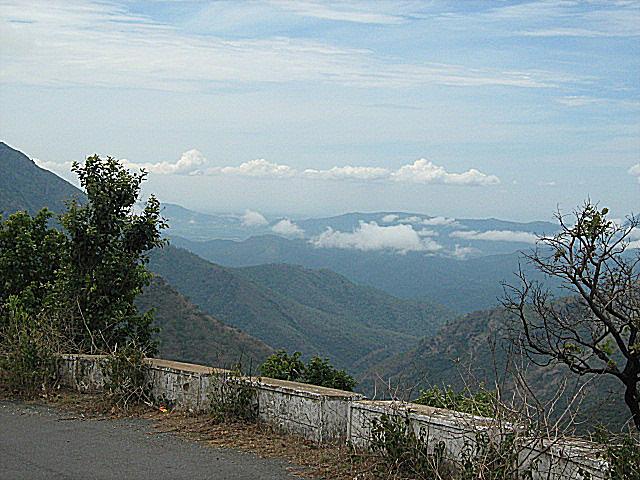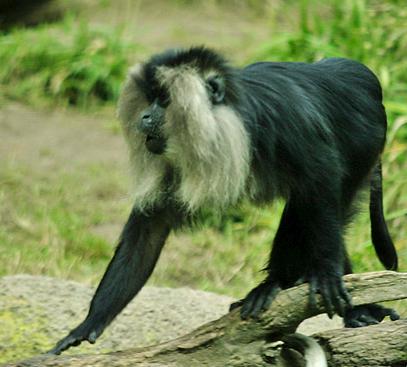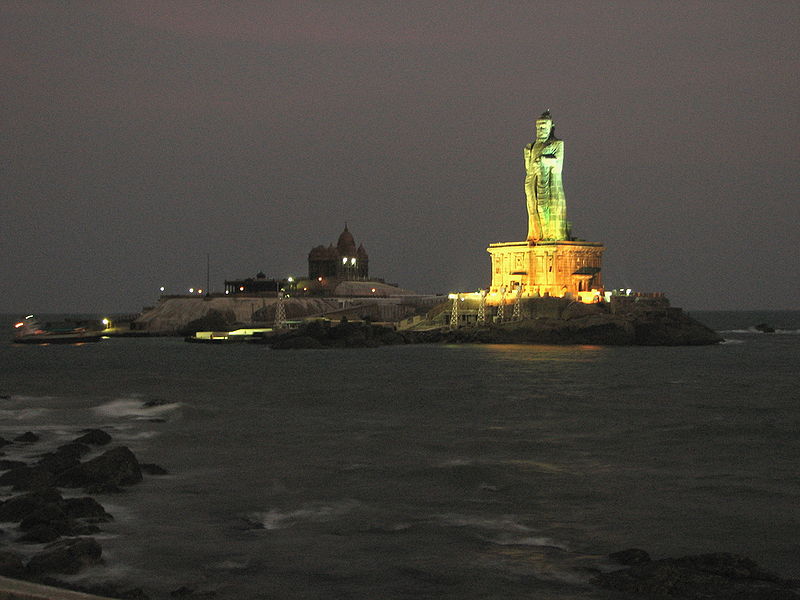HOGENAKKAL WATERFALLS
Hogenakkal Falls or Hogenakal Falls is a waterfall in South India on the river Kaveri. It is located in the Dharmapuri district of the southern Indian state of Tamil Nadu about 180 km (110 mi) from Bangalore and 46 km (29 mi) from Dharmapuri town.It is sometimes referred to as the "Niagara of India". With its fame for medicinal baths and hide boat rides, it is a major tourist attraction. Carbonatite rocks in this site are considered to be the oldest of its kind in South Asia and one of the oldest in the world.This is also the site of a proposed project to generate drinking water.

ROUTE
TRIVANDRUM---KOLLAM---ALAPUZHA---ERNAKULAM---TRISSUR---ALATHUR---MUNDUR---MANNARKKAD---ATTAPADI(VIA SILENT VALLEY)---ANAKATTI---METTUPPALAYAM ROUD---MECHERI---HOGENAKKAL---DHARMAPURI---SALEM---NAMAKKAL---KARUR---DINDUGAL---MADHURAI---THIRUNELVELI---KANYAKUMARI---TRIVANDRUM (ROUND TRIP)
ESTIMATED DAYS OF TRAVEL---10 DAYS(APPROX)
TOTAL DISTANCE ---1320 KMS
PETROL EXPENSE ---RS.1670/-
FOOD ---RS.3000/-
HOTELS AND OTHERS ---RS.5000/-
ATTRACTIONS
ALAPUZHA
Vembanad Lake is at the heart of Kerala Backwaters tourism with hundreds of kettuvallams plied on it and numerous resorts on its banks. The Kumarakom Bird Sanctuary is located on the east coast of the lake. The lake has become a major tourist attraction. A generally safe destination, this place had just one incident of tourist harassment in 2004 as reported in The Times of India.

Over 1.6 million people live on the banks of the Vembanad lake and are directly or indirectly dependent on it for their livelihoods.
The port of Kochi (Cochin) is located at the lake's outlet to the Arabian Sea. The town of Alappuzha (also known as Allepey), sometimes called the "Venice of the East" for its large network of canals that meander through the town - is sandwiched between the lake and the Arabian sea.
ATTAPPADI
Attappadi Reserve Forest is a protected area comprising 249 km² of land covering the westernmost part of the 745 km² Attappadi block of Mannarghat Taluk in Palakkad district of Kerala, south India.

SILENT VALLEY NATIONAL PARK
Silent Valley National Park (Malayalam: സൈലന്റ് വാലീ നാഷണല് പാര്ക്ക്), is a national park with a core zone of 236.74 square kilometres (91 sq mi) (making it the largest national park in Kerala). It is located in the Nilgiri Hills, within thePalakkad District of Kerala, South India. This region was explored in 1847 by the botanist Robert Wight and is a setting for the epic Mahabharatha.
This park is one of the last undisturbed tracts of South Western Ghats mountain rain forests and tropical moist evergreen forestin India. Contiguous with the proposed Karimpuzha National Park (225 km2) to the north and Mukurthi National Park (78.46 km2) to the north-east, it is the core of the Nilgiri International Biosphere Reserve (1,455.4 km2), and is part of The Nilgiri Sub-Cluster (6,000+ km2), Western Ghats World Heritage Site, recognised by UNESCO in 2007.
Plans for a hydroelectric project that threatened the park's rich wildlife stimulated an environmentalist social movement in the 1970s, known as the Save Silent Valley movement, which resulted in cancellation of the project and creation of the park in 1980. The visitors' centre for the park is at Sairandhri.

 Silent Valley is home to the largest population of lion-tailed macaques, an endangered species of primate. Public controversy over their habitat led to the establishment of Silent Valley National Park.
Silent Valley is home to the largest population of lion-tailed macaques, an endangered species of primate. Public controversy over their habitat led to the establishment of Silent Valley National Park.
Territorial forests located around the national park have been subject to a working-plan to accomplish revenue oriented objectives such as extraction of bamboo and reed which affect the long-term conservation of the park. In addition Illegal activities such as ganja cultivation, setting forest fires, trapping and poaching wild animals, frequently occur in the territorial forests located in the immediate vicinity of the national park. This has resulted in degradation of habitat and reduced forest cover, which has adverse effects on the long-term survival of the core area of the national park.
MADHURAI
 Madurai is a major city and cultural headquarters in the state of Tamil Nadu in southern India. It is the administrative headquarters of Madurai District and the 31st largest urban agglomeration in India. Madurai is the second largest city by area and third largest city by population in Tamil Nadu. Located on the banks of River Vaigai, Madurai has been a major settlement for two millennia and is one of the oldest continuously inhabited cities in the world.
Madurai is a major city and cultural headquarters in the state of Tamil Nadu in southern India. It is the administrative headquarters of Madurai District and the 31st largest urban agglomeration in India. Madurai is the second largest city by area and third largest city by population in Tamil Nadu. Located on the banks of River Vaigai, Madurai has been a major settlement for two millennia and is one of the oldest continuously inhabited cities in the world.
The city has a number of historical monuments, with the Meenakshi Amman Temple and Tirumalai Nayak Palace being the most prominent. Madurai is an important industrial and educational hub in South Tamil Nadu. The city is home to various automobile, rubber, chemical and granite manufacturing industries. It has developed as a second-tier city for information technology (IT), and some software companies have opened offices in Madurai. The Tamil Nadu government has planned a satellite town for Madurai near Thoppur.

The National Highways NH 7, NH 45B, NH 208 and NH 49 pass through Madurai.The state highways passing through the city are SH-33, SH-72, SH-72A, SH-73 and SH-73A which connect various parts of Madurai district.Madurai is one of the seven circles of the Tamil Nadu State Highway network. Madurai is the headquarters of the Tamil Nadu State Transport Corporation (Madurai) and provides local and inter-city bus transport across the districts of Madurai, Dindigul, Sivagangai, Theni, Virudhunagar.Madurai has three bus terminals, namely, Mattuthavani Bus Terminus (MIBT) and Arappalayam (for inter city buses) and Periyar Bus stand (for intra city buses). There are 12,754 registered three-wheeled vehicles called auto rickshaws, which are commercially available for renting within the city.In addition to the government operated city buses, there are 236 registered private mini-buses that support local transportation.
KANYAKUMARI
Cape Comorin, is a town in Kanyakumari District in the state of Tamil Nadu in India. The name comes from the Devi Kanya KumariTemple in the region. It is the southernmost tip of peninsular India. Kanyakumari town is the southern tip of the Cardamom Hills, an extension of the Western Ghats range. The nearest town is Nagercoil, the administrative headquarters of Kanyakumari District, 22 km (14 mi) away. Kanyakumari has been a town since Sangam period and is a popular tourist destination.

Since the early 1970s, tourism has been an industry in the town. Because of this it is one of the few small towns in South India where one can hear many of the different languages of India spoken in the street.
Of late, the promotion of tourism has increased, with increasing emphasis on attractions outside the town, such as the surrounding landscapes, as well as the historical and religious sites found around the district. Ultimately a total of 1.9 million tourists (domestic and foreign) visited Kanyakumari in 2007.Though there are several places of tourist-interest in the town and district, Kanyakumari is especially popular in India for its spectacular and unique sunrise and sunset, thanks to its being nearly surrounded by waters. On balmy, full-moon evenings (locally called Chitra Pournami), one can also see the moon-rise and sunset at the same time.

PADMANABHAPURAM PALACE
Padmanabhapuram Palace Malayalam: പത്മനാഭപുരം കൊട്ടാരം is located in at Padmanabhapuram Fort, in Padmanabhapuram, Kanyakumari District, Tamil Nadu, India. Padmanabhapuram is the former capital city of the erstwhile Hindu kingdom of Travancore. It is about 20km from Nagercoil, and about 50km from Thiruvananthapuram, Kerala. The palace is complex inside with an old granite fortress around four kilometers long. The palace is located at the foot of the Veli Hills, which form a part of the Western Ghats. The river Valli flows nearby.

The Padamnabhapuram Palace complex has several other interesting features:
- The palace is located near Thuckalay,Kanyakumari district of Tamil Nadu state but administered by the Government of Kerala state.
- The clock tower in the palace complex has a 300-year-old clock, which still keeps time.
- A big hall now bare, which can accommodate around 1000 guests, and where ceremonial feasts were held, on auspicious occasions.
- A secret passage, now blocked, through which the king, his immediate family members, and their entourage could escape to another palace, located several kilometers away in the event of any emergency. Name of this palace is Charottu kottaram.
- A flight of steps leads to a bathing pond, which has lost its freshness due to neglect and years of disuse.
- The palace complex also has a section of curios and several interesting objects:
- An entire room filled with old Chinese jars, all gifts by Chinese merchants.
- A variety of weapons (which were actually used in warfare), including swords and daggers.
- Brass lamps, wood and stone sculpture, a variety of furniture and large mirrors made of polished metal.
- A gallery of paintings depicting incidents from the history of Travancore.
- A wooden cot made of up to 64 wooden pieces of a variety of medicinal tree trunks
- Polished stone cot, meant for cool effect
- Toilet and well

No comments:
Post a Comment